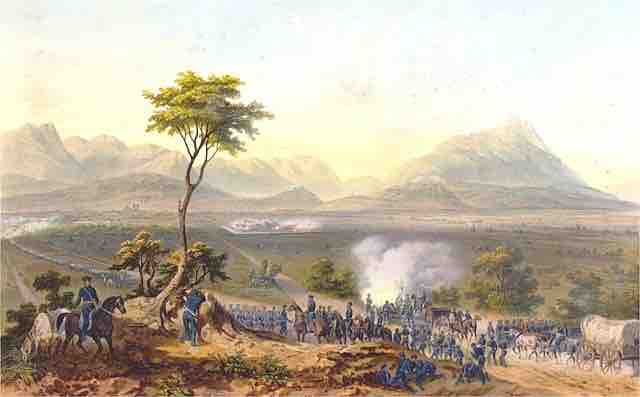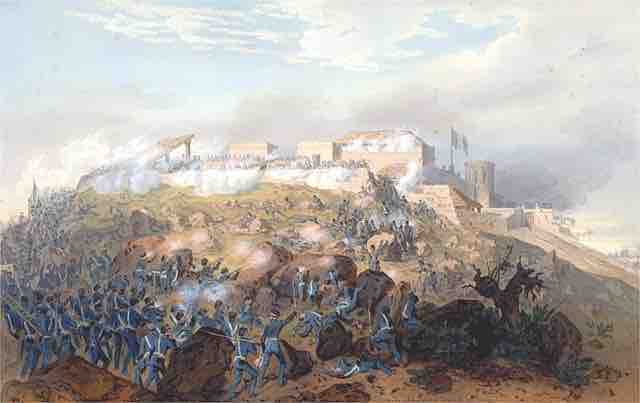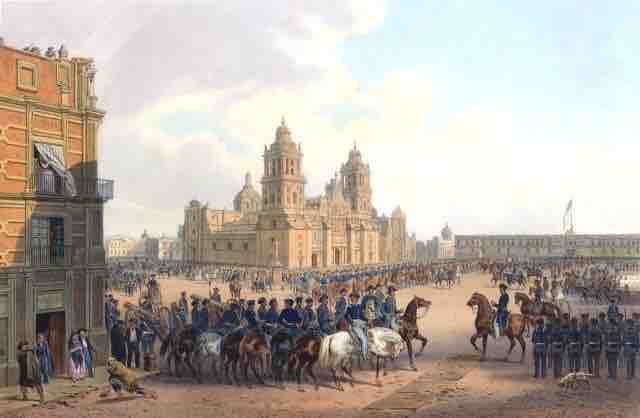Background
The Mexican–American War was an armed conflict between the United States and Mexico that took place in 1846–1848. It occurred in the wake of the 1845 U.S. annexation of Texas, which Mexico considered part of its territory despite the 1836 Texas Revolution in which the Republic of Texas claimed its independence.
The border of Texas as an independent state had never been settled. The Republic of Texas claimed land up to the Rio Grande, based on the Treaties of Velasco. However, Mexico refused to accept these as valid, claiming the border was the Nueces River. U.S. President James Polk endorsed the Rio Grande boundary, which incited a dispute with Mexico.
After a series of failed negotiations with Mexico City, Polk ordered General Zachary Taylor and his forces south to the Rio Grande to enter the territory that Mexicans disputed. On April 25, 1846, a Mexican cavalry detachment routed the patrol, killing 16 U.S. soldiers. In response, Polk asked for a declaration of war. Congress declared war on Mexico on May 13, 1846, after only a few hours of debate.
The War
The US military strategy had three main objectives: 1) Take control of northern Mexico, including New Mexico; 2) seize California; and 3) capture Mexico City. The US War Department sent a cavalry force under General Stephen W. Kearny to invade western Mexico from Jefferson Barracks and Fort Leavenworth, reinforced by a Pacific fleet under John D. Sloat. This was done primarily because of concerns that Britain might also try to seize the area. Two more forces, one under John E. Wool and the other under Taylor, were ordered to occupy Mexico as far south as the city of Monterrey.
California, Kearny, and Sloat
US Army Captain John C. Frémont entered California in December 1845 and was slowly marching to Oregon when he received word that war between Mexico and the United States was imminent. On June 15, 1846, some 30 settlers staged a revolt and seized the small Mexican garrison in Sonoma, California. The republic was in existence scarcely more than a week before the U.S. Army, led by Frémont, took over on June 23.
Commodore John Drake Sloat, upon hearing of imminent war and the revolt in Sonoma, ordered his naval and marine forces to occupy Monterrey on July 7. On July 15, Sloat transferred his command to Commodore Robert F. Stockton who put Frémont's forces under his orders. On July 19, upon receiving official word of the start of war, Frémont's so-called California Battalion entered Monterrey in a joint operation with some of Stockton's sailors and marines. The U.S. forces easily took over the north of California.
From Alta California, Mexican General José Castro and Governor Pío Pico fled southward. When Stockton's forces stopped in San Pedro, Stockton sent 50 U.S. Marines ashore. This force entered Los Angeles unresisted on August 13, 1846. With the success of this "Siege of Los Angeles," the nearly bloodless conquest of California seemed complete.
Meanwhile, General Kearny's forces fought in the decisive Battle of Rio San Gabriel. The next day, January 9, 1847, the Americans fought and won the Battle of La Mesa. On January 12, the last significant body of Californios surrendered to U.S. forces. That marked the end of armed resistance in California, and the Treaty of Cahuenga was signed the next day, on January 13, 1847.
Taylor and Scott's Legacies
Led by Taylor, 2,300 U.S. troops crossed the Rio Grande and headed toward the besieged city of Monterrey. The hard-fought Battle of Monterrey resulted in serious losses on both sides. U.S. soldiers were introduced to urban warfare for the first time and had to adjust their battle tactics accordingly. The Mexican forces under General Pedro de Ampudia eventually surrendered.

Battle of Monterrey
General Zachary Taylor and the US army defeated the Mexican army during the Battle of Monterrey, lasting September 21–24, 1846.
On February 22, 1847, Santa Anna personally marched north to fight Taylor in the Battle of Buena Vista. Furious fighting ensued, during which the U.S. troops were nearly defeated but managed to cling to their entrenched position. Rather than reinforce Taylor's army for a continued advance, Polk sent a second army under General Winfield Scott to begin an invasion of the Mexican heartland.
On March 9, 1847, Scott performed the first major amphibious landing in U.S. history in preparation for the Siege of Veracruz. Meanwhile, mortars and naval guns reduced the city walls. The effect of the extended barrage destroyed the will of the Mexican side to fight, and they surrendered the city after 12 days under siege.
Scott then advanced on Mexico City on August 7. The capital was laid open in a series of battles, culminating in the Battle of Chapultepec. On September 14, 1847, When Scott entered Mexico City’s central plaza the city had fallen. While Polk and other expansionists called for “all Mexico,” the Mexican government and the United States negotiated for peace in 1848, resulting in the Treaty of Guadalupe Hidalgo.

Battle of Chapultapec
U.S. forces began their assault on Chapultapec, the main fort protecting Mexico City, on September 12, 1847, with an artillery barrage.

U.S. Occupation of Mexico City
This 1851 painting by Carl Nebel shows the U.S. occupation of Mexico City, which began after US forces captured the city in September 1847.
Treaty of Guadalupe Hidalgo
The Treaty of Guadalupe Hidalgo, signed in February 1848, was a triumph for U.S. expansionism under which Mexico ceded nearly half its land. The Mexican Cession, as the conquest of land west of the Rio Grande was called, included the current states of California, New Mexico, Arizona, Nevada, Utah, and portions of Colorado and Wyoming. Mexico also came to recognize the Rio Grande as the border with the United States. Mexican citizens in the ceded territory were promised U.S. citizenship in the future when the territories they were living in became states. In exchange, the United States agreed to assume $3.35 million worth of Mexican debts owed to U.S. citizens, paid Mexico $15 million for the loss of its land, and promised to guard the residents of the Mexican Cession from American Indian raids.